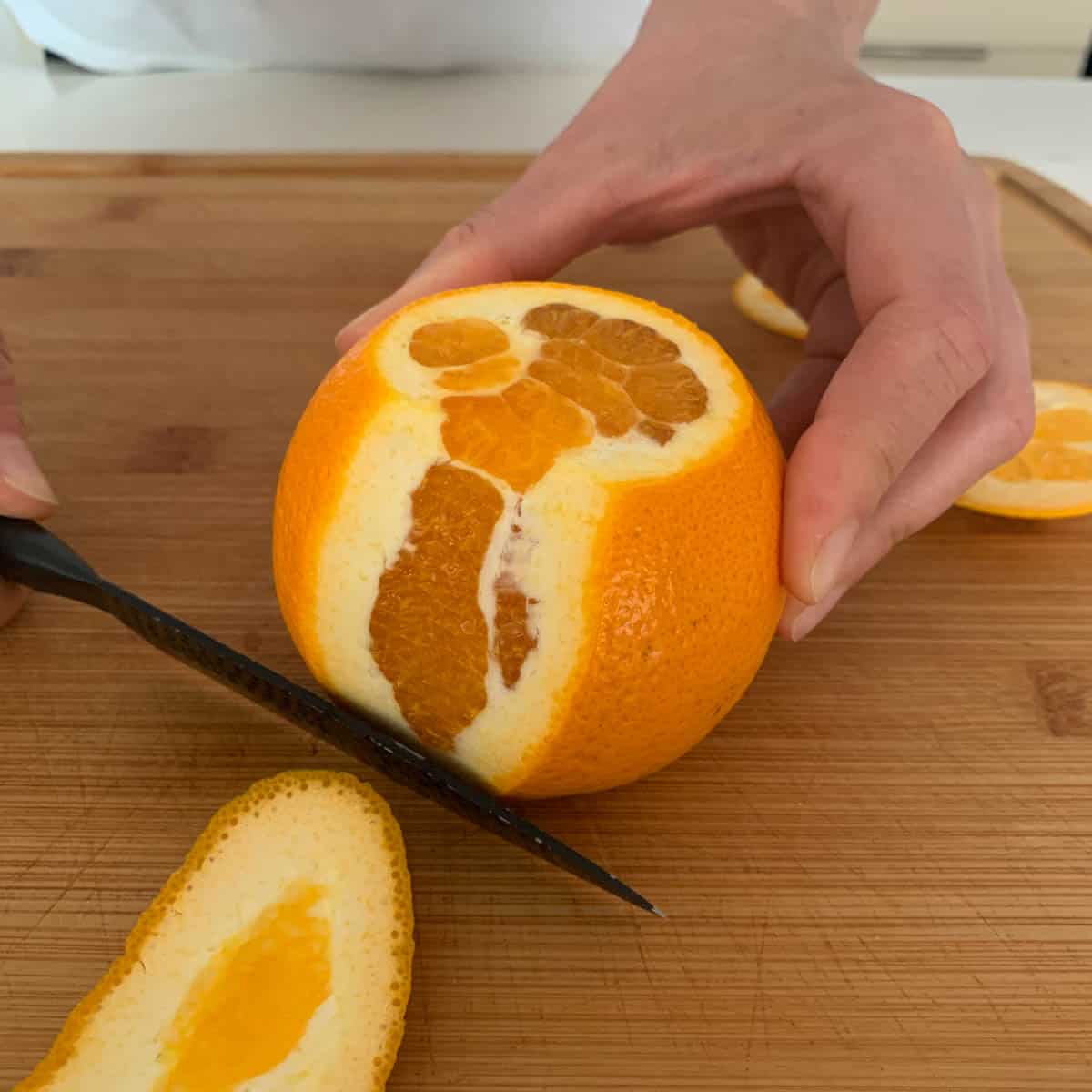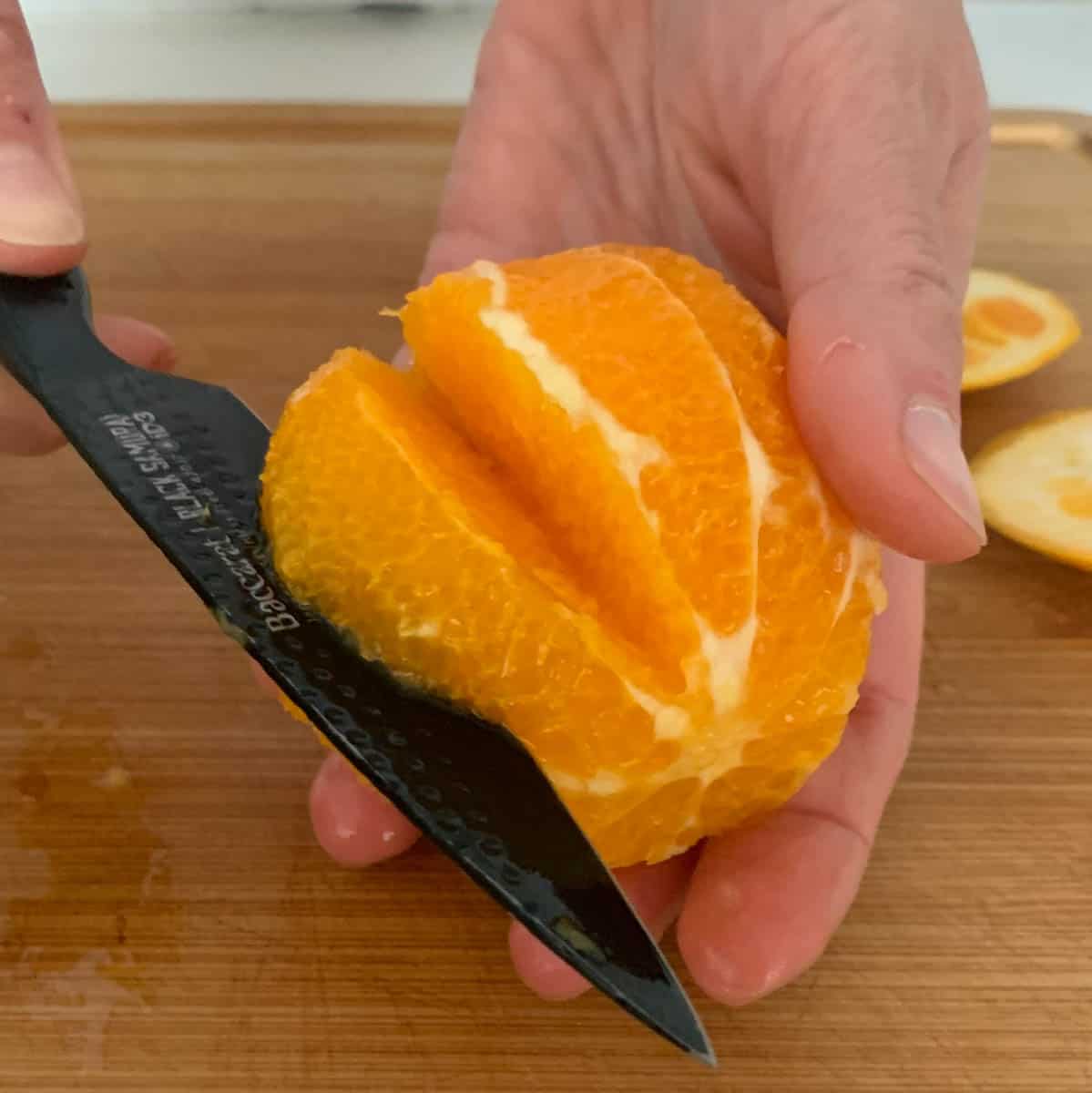How to cut an orange into segments
This post contains affiliate links
Need to prepare orange segments for a recipe and feeling uncertain? No need to panic — I’ll guide you through the process in just 5 minutes. It is much easier than you might imagine.
The post has extra tips to make sure the recipe comes out amazing on your first try. If you're in a rush, use the link above to jump to the recipe card at the end! 👩🍳🔝

Oranges have always been a favorite citrus fruit for many, including me and my family. It’s easy to see why; with their vibrant color and juicy sweetness, oranges are not only delicious but also packed with vitamin C. Which makes them a perfect after-school snack.
But oranges can be so much more than just a snack. From orange cakes and muffins to fruit salads and smoothies. You can use oranges to make delicious marinades and salad dressings. Try my zesty Chinese chicken and orange salad, or the creamy orange overnight oats.
Three tips on how to choose oranges 🛒
First thing first, let’s have a look at what to look out for when shopping for oranges. Follow these simple tips to choose the best quality oranges:
- Weight: Opt for oranges that feel heavy in your hand, like a small sports ball; heaviness indicates juiciness.
- Aroma: Give the orange a quick sniff; ripe and sweet oranges emit a beautiful citrus scent through their skin.
- Firmness and Texture: Ensure the orange is firm and lacks mushy spots, and look for skin with a smooth, slightly bumpy texture, a sign of freshness.
How to cut an orange into segments
There are different ways to master this skill of cutting an orange, but all of them will start with a good chef’s knife and a chopping board. Let’s dive in 👩🍳:
💡 Supreming
Did you know that cutting an orange into segments is a technique known as supreming?
It is a French culinary method employed to separate the zest and bitter pith from the flesh of the orange, allowing it to be presented in elegant slices.
This French technique works for any different types of oranges such as navel oranges, blood oranges, sweet oranges, or even sour oranges for an exciting twist.
1. Prepare the Orange 🍊:
- Start by washing the orange under cool running water to ensure it’s clean. Pat it dry with a paper towel.
2. Cut Off the Ends:
- Using a sharp paring knife or a small chef’s knife, slice off both ends of the orange to create flat surfaces. This is the first step in any citrus supreme technique.
3. Remove the Peel:
- With the base of the orange resting on the cutting board, follow the curve of the orange from top to bottom, cutting away the outer peel and the bitter white pith.


4. Locate the Membranes:
- Once you’ve removed the outer peel and are left with the naked orange flesh, you’ll notice natural lines and membranes separating the segments.
5. Segment the Orange:
- Once you’ve removed all outer peels and are left with the naked orange flesh, you’ll notice natural lines and membranes separating the segments.
- Place a peeled orange into the palm of your hand, (non-dominant hand), and using your knife, carefully insert it just inside one of the membrane lines and cut towards the center of the orange. This releases the citrus segments – skinless orange wedges.
- Repeat this process for all the segments.


Remember, it may take a little practice to achieve perfect orange segments, but with a little bit of patience, the right knife skills, and a really sharp knife, you’ll be mastering the skill of segmenting the orange in no time.
❄️ How to store orange segments
If not serving immediately, store the citrus segments in an airtight container in the crisper drawer of your refrigerator for 2-3 days.
Orange segments are very juicy and don’t freeze well. They are best to enjoy when fresh.

What to do with the orange peel
Don’t hurry to through away the orange peel. You can make a simple and effective orange and vinegar cleaning solution.
To make a handy orange peel cleaning solution, start by saving your orange peels, then place them in a glass jar and cover them with white vinegar. Let the mixture sit for about 3 weeks, strain out the peels, and you’re left with a citrus-infused vinegar.
Dilute this with an equal amount of water, put it in a spray bottle, and you’ve got a natural cleaner that can tackle various surfaces, removing dirt and odors, all while leaving a refreshing orange aroma.
Recipes with oranges
Did you find the How to Cut an Orange into Segments tutorial helpful? If so, I’d greatly appreciate it if you could leave a star rating and share your thoughts in a comment. Your feedback means a lot to me, and it can also help others who are interested in trying it out. Thank you! 🌟👩🍳

How to cut orange into segments
Equipment
- 1 Chef's knife
- 1 Chopping board
Ingredients
- 1 orange
Instructions
- Prepare the Orange 🍊: Start by washing the orange under running water and pat it dry with a paper towel to ensure it's dry and clean.
- Cut Off the Ends: Using a sharp paring knife or a small chef's knife, slice off both ends of the orange to create flat surfaces. This is the first step in any citrus supreme technique.
- Remove the Peel: With the base of the orange resting on the cutting board, follow the curve of the orange from top to bottom, cutting away the outer peel and the bitter white pith.
- Locate the Membranes: Once you've removed the outer peel and are left with the naked orange flesh, you'll notice natural lines and membranes separating the segments.
- Segment the Orange: Place the peeled orange on the palm of your hand and using your knife, carefully insert it just inside one of the membrane lines and cut towards the center of the orange. This releases the citrus segments. Repeat this process for all the segments. Voila, you now have the most beautiful orange segments!









Danke Lenohka, eine sehr interessante Methode.